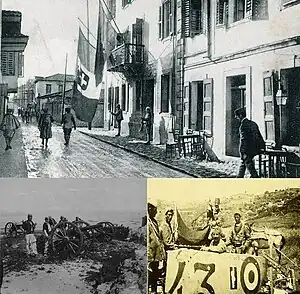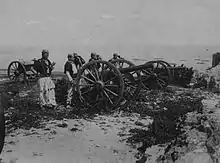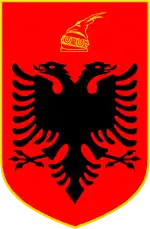Vlora War
The Vlora War was a military conflict in the Vlora region of Albania between the Kingdom of Italy and Albanian nationalists, who were divided into small groups of fighters.[6] The war lasted three months until an armistice, whose terms forced Italy to give up plans to turn Albania into a mandate and relinquish Vlorë. In exchange, Italy retained a diplomatic protection over Albania to guarantee the country's independence and was allowed to annex the island of Saseno. This settlement was confirmed within the League of Nations by the Conference of Ambassadors a year later. The Vlora War is seen as a turning point in the establishment of Albanian independence.[6][7][8]
| Vlora War | |||||||||
|---|---|---|---|---|---|---|---|---|---|
 Clockwise from top: Italian base; Albanian soldiers; Italian cannons captured by Albanian irregulars during one of the battles | |||||||||
| |||||||||
| Belligerents | |||||||||
|
|
| ||||||||
| Commanders and leaders | |||||||||
|
Qazim Koculi Ahmet Lepenica Selam Musai † Spiro Jorgo Koleka Fani Shuka |
Giovanni Giolitti Settimio Piacentini Enrico Gotti † | ||||||||
| Strength | |||||||||
| 10,000 troops, of which 3,000–4,000 engaged[3] | About 25,000 troops,[4] with only a fraction engaged due to an oubreak of malaria[5] | ||||||||
| Casualties and losses | |||||||||
| Unknown | Unknown | ||||||||
- Revolutions of 1917–1923
- Aftermath of World War I 1918–1939
- Allied intervention in the Russian Civil War 1918–1925
- Province of the Sudetenland 1918–1920
- 1918–1920 unrest in Split
- Soviet westward offensive of 1918–1919
- Heimosodat 1918–1922
- Austro-Slovene conflict in Carinthia 1918–1919
- Hungarian–Romanian War 1918–1919
- Hungarian–Czechoslovak War 1918–1919
- 1919 Egyptian Revolution
- Christmas Uprising 1919
- Irish War of Independence 1919
- Comintern World Congresses 1919–1935
- Treaty of Versailles 1919
- Shandong Problem 1919–1922
- Polish–Soviet War 1919–1921
- Polish–Czechoslovak War 1919
- Polish–Lithuanian War 1919–1920
- Silesian Uprisings 1919–1921
- Treaty of Saint-Germain-en-Laye 1919
- Turkish War of Independence 1919–1923
- Venizelos–Tittoni agreement 1919
- Italian Regency of Carnaro 1919–1920
- Iraqi Revolt 1920
- Treaty of Trianon 1920
- Vlora War 1920
- Treaty of Rapallo 1920
- Little Entente 1920–1938
- Treaty of Tartu (Finland–Russia) 1920–1938
- Mongolian Revolution of 1921
- Soviet intervention in Mongolia 1921–1924
- Uprising in West Hungary 1921–1922
- Franco-Polish alliance 1921–1940
- Polish–Romanian alliance 1921–1939
- Genoa Conference (1922)
- Treaty of Rapallo (1922)
- March on Rome 1922
- Sun–Joffe Manifesto 1923
- Corfu incident 1923
- Occupation of the Ruhr 1923–1925
- Treaty of Lausanne 1923–1924
- Mein Kampf 1925
- Second Italo-Senussi War 1923–1932
- First United Front 1923–1927
- Dawes Plan 1924
- Treaty of Rome (1924)
- Soviet–Japanese Basic Convention 1925
- German–Polish customs war 1925–1934
- Treaty of Nettuno 1925
- Locarno Treaties 1925
- Anti-Fengtian War 1925–1926
- Treaty of Berlin (1926)
- May Coup (Poland) 1926
- Northern Expedition 1926–1928
- Nanking incident of 1927
- Chinese Civil War 1927–1937
- Jinan incident 1928
- Huanggutun incident 1928
- Italo-Ethiopian Treaty of 1928
- Chinese reunification 1928
- Lateran Treaty 1928
- Central Plains War 1929–1930
- Young Plan 1929
- Sino-Soviet conflict (1929)
- Great Depression 1929
- London Naval Treaty 1930
- Kumul Rebellion 1931–1934
- Japanese invasion of Manchuria 1931
- Pacification of Manchukuo 1931–1942
- January 28 incident 1932
- Soviet–Japanese border conflicts 1932–1939
- Geneva Conference 1932–1934
- May 15 incident 1932
- Lausanne Conference of 1932
- Soviet–Polish Non-Aggression Pact 1932
- Soviet–Finnish Non-Aggression Pact 1932
- Proclamation of the Kingdom of Saudi Arabia 1932
- Defense of the Great Wall 1933
- Battle of Rehe 1933
- Nazis' rise to power in Germany 1933
- Reichskonkordat 1933
- Tanggu Truce 1933
- Italo-Soviet Pact 1933
- Inner Mongolian Campaign 1933–1936
- Austrian Civil War 1934
- Balkan Pact 1934–1940
- July Putsch 1934
- German–Polish declaration of non-aggression 1934–1939
- Baltic Entente 1934–1939
- 1934 Montreux Fascist conference
- Stresa Front 1935
- Franco-Soviet Treaty of Mutual Assistance 1935
- Soviet–Czechoslovakia Treaty of Mutual Assistance 1935
- He–Umezu Agreement 1935
- Anglo-German Naval Agreement 1935
- December 9th Movement
- Second Italo-Ethiopian War 1935–1936
- February 26 incident 1936
- Remilitarization of the Rhineland 1936
- Soviet-Mongolian alliance 1936
- Arab revolt in Palestine 1936–1939
- Spanish Civil War 1936–1939
- Anglo-Egyptian treaty of 1936
- Italo-German "Axis" protocol 1936
- Anti-Comintern Pact 1936
- Suiyuan campaign 1936
- Xi'an Incident 1936
- Second Sino-Japanese War 1937–1945
- USS Panay incident 1937
- Anschluss Mar. 1938
- 1938 Polish ultimatum to Lithuania Mar. 1938
- Easter Accords April 1938
- May Crisis May 1938
- Battle of Lake Khasan July–Aug. 1938
- Salonika Agreement July 1938
- Bled Agreement Aug. 1938
- Undeclared German–Czechoslovak War Sep. 1938
- Munich Agreement Sep. 1938
- First Vienna Award Nov. 1938
- German occupation of Czechoslovakia Mar. 1939
- Hungarian invasion of Carpatho-Ukraine Mar. 1939
- German ultimatum to Lithuania Mar. 1939
- Slovak–Hungarian War Mar. 1939
- Final offensive of the Spanish Civil War Mar.–Apr. 1939
- Danzig crisis Mar.–Aug. 1939
- British guarantee to Poland Mar. 1939
- Italian invasion of Albania Apr. 1939
- Soviet–British–French Moscow negotiations Apr.–Aug. 1939
- Pact of Steel May 1939
- Battles of Khalkhin Gol May–Sep. 1939
- Molotov–Ribbentrop Pact Aug. 1939
- Invasion of Poland Sep. 1939
Background
Before entering the First World War as an ally of Triple Entente, the Kingdom of Italy had signed the secret Treaty of London: Italy promised to declare war against Germany and Austria-Hungary within a month in exchange for some territorial gains at the end of the war. The promised territories of Albania to Italy were treated in Articles 6 and 7 of the treaty:[9]
Article 6 Italy shall receive full sovereignty over Valona, the island of Saseno and surrounding territory....
Article 7 Having obtained the Trentino and Istria by Article 4, Dalmatia and the Adriatic islands by Article 5, and also the gulf of Valona, Italy undertakes, in the event a small, autonomous, and neutralized state being formed in Albania Italy not to oppose the possible desire of France, Great Britain, and Russia to repartition the northern and the southern districts of Albania between Montenegro, Serbia, and Greece. The southern coast of Albania, from the frontier of the Italian territory of Valona to Cape Stilos, is to be neutralized. The Italy will be conceded the right of concluding the foreign relations of Albania; in any case, Italy will be bound to secure for Albania a territory sufficiently extensive to enable its frontiers to join those of Greece and Serbia to the west of Lake Ochrida ..
In 1920 in allies in the Paris Peace Conference had still reached no decision on Albania's future, but Italy's claims to sovereignty over Vlorë had never been seriously challenged. Italian Prime Minister Francesco Saverio Nitti had also hoped to obtain a mandate over the rest of the country according to the secret Treaty of London.[10]
Orders of battle
Albanian order of battle
| Albanian order of battle | |||||
|---|---|---|---|---|---|
| Forces from Shullëri | Commander Kalo Telhai | ||||
| Forces from Kutë | Commander Rrapo Çelo and Halim Rakipi | ||||
| Forces from Dukat | Commander Sheme Sadiku and Hodo Zeqiri | ||||
| Forces from Lumi i Vlorës | Commander Sali Vranishti | ||||
| Forces from Fëngu | Commander Muço Aliu | ||||
| Forces from Kanina | Commander Beqir Velo | ||||
| Forces from Salari | Commander Selam Musai | ||||
| Forces from Kurvelesh | Commander Riza Runa | ||||
| Forces from Fterra | Commander Xhaferr Shehu | ||||
| Forces from Mallakastër | Commander Bektash Çakrani and Halim Hamiti | ||||
| Forces from Skrapar | Commander Riza Kodheli | ||||
| Forces from Berat | Commander Seit Toptani and Izedin Vrioni and Fani Shuka | ||||
| Forces from Peqin | Commander Adem Gjinishi | ||||
| Forces from Gjirokastër | Commander Javer Hurshiti and Xhevdet Picari | ||||
| Forces from Çamëria | Commander Alush Seit Taka and Muharrem Rushiti | ||||
| Forces from Korça | Captain Ferit Frashëri and Tosun Selenica | ||||
| Forces from Tirana | Captain Ismail Haki Kuçi | ||||
| Albanian-American Volunteers | Captain Aqif Përmeti and Kareiman Tatzani | ||||
Italian order of battle
| Italian order of battle | |||||
|---|---|---|---|---|---|
| Area | Military Strength | Commander | |||
| Vlorë-Kaninë area | Center of High Command of 36th division forces | Commander: General Settimo Piacentini. Division commander - General Emanuele Pugliese and his aid General De Luca. | |||
| Kotë | Road, food and hospital center. 4th command of mixed artillery. Alpine battalion, 72nd battalion of Infantry. | Command of Carabinieri forces. Commander General Enrico Gotti, Commander of the garrison Cavallo Michele. | |||
| Gjorm | Center of a machine gun company | Commander Captain Bergamaschi | |||
| Matohasanaj Castle | 72 infantry battalion, infantry regiment, 182nd mountain artillery section 70 mm. | Commander major | |||
| Tepelenë Castle | Infantry battalion, 157th artillery section, carabinieri forces. | Commander major Bronzini. | |||
| Llogara Pass | Part of 35th battalion of 35th regiment of bersaglieri, 105th repart. | Commander Captain Boansea | |||
| Himarë | Center of command of 35th regiment of bersaglieri. | Commander general Rossi, Colonel Manganeli. | |||
| Selenicë | Commander major Guadalupi | ||||
| Vlora Gulf | Battleships "San Mario", "Bruceti", "Dulio", Alkina" Orion, torpedinier "Arcione" | ||||
| Ujë i Ftohtë region (outskirt south of Vlorë) | Aviation forces | ||||
| Panaja | Central magazines of the Italian army | ||||
| Vajzë - hospital and post command. | |||||
Course of war
.svg.png.webp)
The war started on June 4, after Italian General Settimo Piacentini refused to hand over the Vlora district to the Albanian government. Albania had previously forced much of the Italian occupation to leave the country, but after demands by Ahmet Zogu, the then interior-minister of Albania, to continue the evacuation were rejected by Italy, the Albanians announced the establishment of the National Defense Committee under the leadership of Qazim Koculi and began to gather volunteers.[6] Ahmet Lepenica became the commander in chief of the detachment consisting of around 4000 men. The Albanian insurgents were poorly armed, and not everyone even carried a gun; some were armed with nothing but sticks and stones. In and around Vlora were around 25,000 Italian soldiers who were stationed in the area with artillery.[6]
The Albanians engaged in fighting in the Vlora region, and soon the rebels were bolstered by volunteers in the region. This increased the size of the force to upwards of 10,000 irregulars, which also included the Banda e Vatrës, an Albanian military band that was formed in the United States that travelled 23 days by boat from the US to Durrës. However, during the course of warfare not more than 4,000 Albanians engaged.[11][6] The advance of the Albanian troops as well as communist revolutionary movements and riots within the army in Italy made reinforcements to the Italian soldiers in Vlora impossible.[12][6] Italian soldiers remained barricaded inside Vlora, without orders and with malaria and communist agitation spreading among the ranks.[6][12]
End of hostilities

The military stalemate lasted for three months, until the following protocol (the Treaty of Tirana) was signed between the Italian and the Albanian governments:
Italy undertakes to recognize and defend the autonomy of Albania and, retaining only Saseno, abandons Vallona.
It was the first diplomatic pact between Albania and a foreign power. The agreement rescued the territory of the Albanian state from further partition. Albania had used all its influence to obtain full and unreserved recognition by the Western powers of the independence of Albania within 1913 borders.[13]
The armistice, introducing a ceasefire on 5 August, contained these main points:
- The Italian Government completely acknowledged the independence, territorial integrity, and sovereignty of Albania, within the frontiers defined in 1913 by the Conference of Ambassadors in London.
- The Italian government relinquished its protectorate proclaimed in 1917 and the occupation and administration of Vlorë and its hinterland, and renounced all claims against Albania and all interference in Albanian political affairs, and abandoned the idea of a mandate over the country.
- The Italian government agreed to withdraw its war materials from Vlorë and its hinterland, to evacuate all its holdings on the Albanian mainland, and to repatriate at an early date the Italian troops actually stationed in Vlorë and on the littoral, and all its forces still remaining in other parts of Albanian territory with the exception of the garrison on the island of Sazan at the entrance of the Vlorë bay; Italy retained the permanent possession only of the island of Sazan, but remained in temporary occupation of Cape Linguetta and cape Treporti, both dominating Vlorë bay, with the right to fortify them; the detachment of troops at Shkodër was also to remain in that town.
- There would take place an exchange of prisoners, the liberation of arrested persons under a general mutual amnesty, and the settlement of outstanding questions concerning the private interests of Albanian and Italian subjects.
The agreement was confirmed within the League of Nations by the Conference of Ambassadors, in November 1921; the declaration of the Ambassadors again affirmed Albanian independence and recognized Italian special interests in Albania. Giovanni Giolitti, the Italian prime minister of the time, was satisfied by the Treaty of Tirana and described it in these terms:
What really interests us is that Vallona cannot form a base of operations against us; and this aim was achieved with the occupation of the islet of Sasseno, which lies at the mouth of the bay itself... For these reasons, I decided to renounce the mandate conferred on us by the Paris Conference on Albania, which would have represented an enormous liability without any profit, and to limit our action to the diplomatic protection of Albania against the aims of other States, and to abandon Vallona, ensuring however recognition of the possession of Sasseno
On the other hand, Benito Mussolini described Vlora as the "Albanian Caporetto".[1] However, when he rose to power, he too became a guarantor of Albanian independence and unleashed the crisis of Corfu following a dispute with Greece over the Albanian border.
References
- Arhire, Sorin; Roşu, Tudor, eds. (2019). The Paris Peace Conference (1919-1920) and Its Aftermath: Settlements, Problems and Perceptions. Cambridge Scholars Publishing. p. 112. ISBN 9781527543959.
... the political quarrel turned into an armed conflict, which ended with the unexpected victory of the Albanians.
- Giovanni Giolitti "Memorie della mia vita", Milan: F.lli Treves, 1922.)
- Krasniqi, Kolë (2019). Islamist Extremism in Kosovo and the Countries of the Region. Cham: Springer. ISBN 978-3-030-18569-5. OCLC 1119613159.
- Marmullaku, Ramadan (1975). Albania and the Albanians. Hamden, Conn.: Archon Books. ISBN 0-208-01558-2. OCLC 1963173.
- Vincenzo Gallinari, l'esercito italiano nel primo dopoguerra, 1918-1920, p.157
- Albanian identities: myth and history Authors Stephanie Schwandner-Sievers, Bernd Jürgen Fischer Editors Stephanie Schwandner-Sievers, Bernd Jürgen Fischer Edition illustrated Publisher C. Hurst & Co. Publishers, 2002 ISBN 1-85065-572-3, ISBN 978-1-85065-572-5
- Ruggero Giacomini, La rivolta dei bersaglieri e le Giornate Rosse - I moti di Ancona dell'estate del 1920 e l'indipendenza dell'Albania, Assemblea legislativa delle Marche, Ancona 2010.
- Paolini M., I fatti di Ancona e l'11º Bersaglieri (giugno 1920), in "Quaderni di Resistenza Marche", n. 4 novembre 1982.
- Southern Albania, 1912-1923 Publisher Stanford University Press ISBN 0-8047-6171-X, 9780804761710 p.61
- Italy from liberalism to fascism, 1870-1925 Author Christopher Seton-Watson Edition illustrated Publisher Taylor & Francis, 1967 ISBN 0-416-18940-7, ISBN 978-0-416-18940-7 p. 578
- "BANDA DHE VULLNETARËT E VATRËS NË LUFTËN E VLORËS DHE NË KONFLIKTIN ME GREKËT NË KUFIJTË JUGORË". gazetadielli.com. Retrieved 21 March 2018.
- "Gli Italiani si ritirano dall'Albania". digilander.libero.it. Retrieved 21 August 2018.
- Albania and King Zog: independence, republic and monarchy 1908-1939 Volume 1 of Albania in the twentieth century, Owen Pearson Volume 1 of Albania and King Zog, Owen Pearson Author Owen Pearson Edition illustrated Publisher I.B.Tauris, 2004 ISBN 1-84511-013-7, ISBN 978-1-84511-013-0 page 151
Further reading
- Akademia e Shkencave e RPSSH "Fjalori Enciklopedik Shqiptar", Tirana, 1985.
- Pearson, Owen. Albania in the Twentieth Century: A History. Volume One. New York: I.B. Tauris, 2006 (ISBN 1-84511-013-7).
- Sette, Alessandro. From Paris to Vlorë. Italy and the Settlement of the Albanian Question (1919-1920), in The Paris Peace Conference (1919-1920) and Its Aftermath: Settlements, Problems and Perceptions, eds. S. Arhire, T. Rosu, Cambridge Scholars Publishing, Newcastle upon Tyne, 2020.
